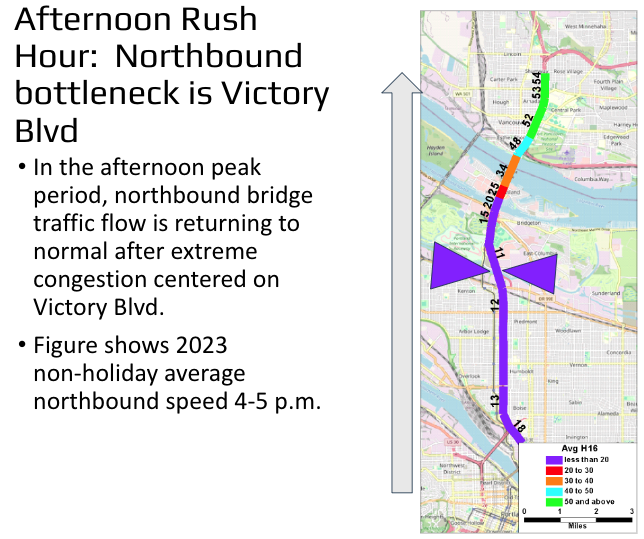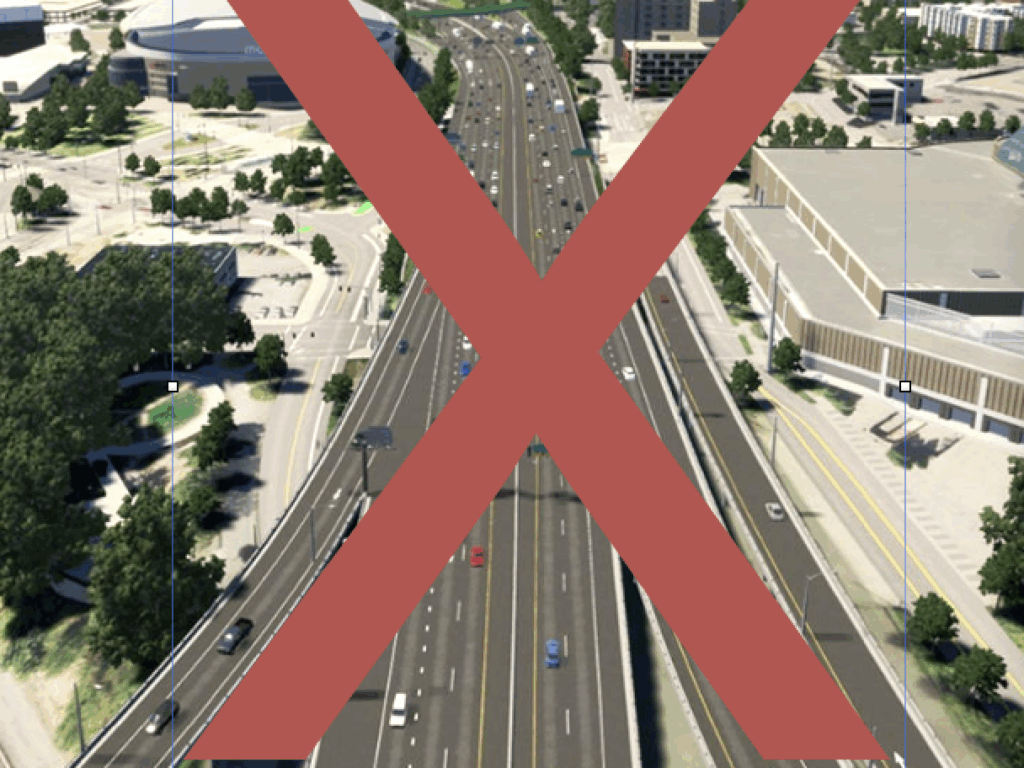What City Observatory Did This Week
A Non-Denial Denial: An independent traffic analysis of the proposed $7.5 billion Interstate Bridge Replacement (IBR) project shows that it won’t solve the actual traffic bottleneck between Portland and Vancouver. In response, bridge advocates have offered a statement purporting to dispute the study, which actually doesn’t deny its accuracy.
 IBR and Metro effectively admit critics are right about problems with their traffic modeling. National modeling expert Norm Marshall took a close look at the traffic data for the I-5 corridor and found that traffic actually flows more smoothly through the I-5 bridge area than it does through the adjacent freeway to the south–meaning the real bottleneck is not where they are widening the roadway, but further south. As a result the freeway widening won’t solve daily congestion. IBR staff and Metro offer vague and contradictory statements. IBR’s Greg Johnson concedes they won’t do anything to fix the bottlenecks outside the project area. Metro asserts that its static traffic modeling–which consistently over-predicts I-5 traffic volumes is acceptable, but Marshall’s dynamic traffic modeling better explains what is happening, and what will happen on I-5.
IBR and Metro effectively admit critics are right about problems with their traffic modeling. National modeling expert Norm Marshall took a close look at the traffic data for the I-5 corridor and found that traffic actually flows more smoothly through the I-5 bridge area than it does through the adjacent freeway to the south–meaning the real bottleneck is not where they are widening the roadway, but further south. As a result the freeway widening won’t solve daily congestion. IBR staff and Metro offer vague and contradictory statements. IBR’s Greg Johnson concedes they won’t do anything to fix the bottlenecks outside the project area. Metro asserts that its static traffic modeling–which consistently over-predicts I-5 traffic volumes is acceptable, but Marshall’s dynamic traffic modeling better explains what is happening, and what will happen on I-5.
Must Read
Another failing report card on the nation’s infrastructure. As they routinely do, the American Society of Civil Engineering handed out a “D+” grade for the nation’s roads. It’s meant to be a thinly veiled plea for even greater spending on roads, pipes and other engineering, but in reality is a prodigious self-own. Transportation for America recounts how we’ve spent a trillion and a half dollars on roads in the past couple of decades, and things have only gotten worse. While the engineers think the solution is to be found by simply dumping more money into the same failed solutions, the reality is we need different and better infrastructure (and related policies), not more money for road building. While Transportation for America notes that unlike previous report cards, the engineers will now concede that we can’t build our way out of congestion, the organization nonetheless simply calls for spending more money without actually changing any policies:
After 27 years, ASCE has evolved. But they aren’t quite ready to admit that the federal government has spent $1.5 trillion since 1991 on surface transportation and it’s resulted in subpar transit systems, crumbling roads and bridges that aren’t improving enough, historic levels of traffic deaths, and the largest sector for emissions. If you think that doubling that price tag is going to improve those outcomes, I’ve got a (poor condition) bridge to sell you.
As with health care, the US spends vastly more on roads, and has dramatically worse results than other developed countries. Professional engineers should reflect on that when they next hand out grades.
There’s mounting evidence that congestion pricing is the most effective and fast-acting solution to urban traffic problems we’ve ever seen. The latest data come from traffic monitoring firm Tom Tom. According to Tom Tom’s measures, congestion has fallen by about a third compared to a year ago.

As the Tom Tom analysts report, the gains were most noticeable in the evening peak hour:
Evening peak hours saw some of the most dramatic changes. In early 2024, congestion during the 3 p.m. to 5 p.m. rush hour averaged a staggering 43.2%. In 2025, that number has dropped to 30.3%, shaving off nearly five minutes of the time it takes to travel 10 kilometers during peak congestion. Beyond just reducing the time drivers spend stuck in traffic, congestion pricing has cut the total distance driven in the tolled area by millions of kilometers. That means fewer emissions, cleaner air, and a more livable city.
Why abundance of the wrong kind of transportation would be a disaster. David Zipper weighs in on the wonk topic du jour: Abundance. Like our friend Tony Dutzik, he cautions that a simple-minded application of the abundance principle to transportation is, actually, what got us into this mess. Along the way we paid little or no attention to the externalities associated with a car-dependent transportation system. The idea of “more abundant roads” could easily be turned on what meager progress has been made in making roads safer, reducing pollution, and creating fundamentally alienating sprawling environments.
But be careful what you wish for. State departments of transportation are infatuated with roadbuilding, and reducing construction costs may simply encourage agencies to add lanes to already overbuilt highways. That outcome would be counterproductive for climate and road safety goals.
In many ways, the theme abundance is an effort to avoid the gnarly and important questions of what kind of world we want to live in, and offers support for the “all of the above” policies that have been continually used to rationalize “more of the same” when it comes to highways and sprawl. No one should be fooled.
In the news
City Observatory’s Joe Cortright was interviewed on Oregon Public Broadcasting’s “Think Out Loud” about the role of mismanagement and cost-overruns driving the Oregon Department of Transportation’s financial problems. Listen to the full 13 minute interview.
The Portland Mercury quoted City Observatory’s Joe Cortright in its analysis of Metro’s approval of the I-5 Rose Quarter freeway widening project.
Some advocates have previously said ODOT’s supposedly conservative expansion plans are anything but. According to Joe Cortright, ODOT watchdog and co-founder of the group No More Freeways, ODOT records show the agency actually plans to double or triple the width of the freeway, leaving room to add more lanes in the future.
Follow City Observatory on Bluesky

